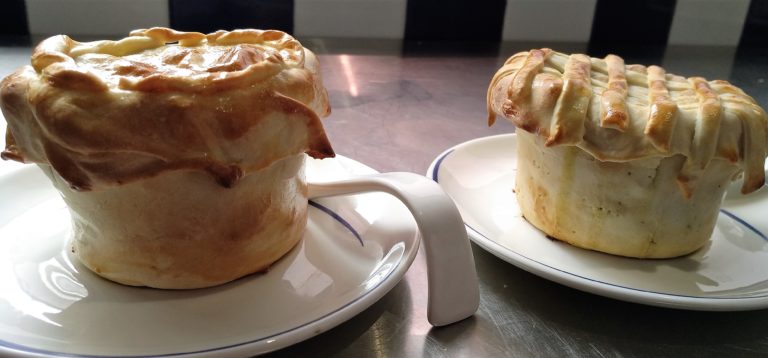Manhattan clam chowder is a soup customarily produced using clams, pork, herbs, tomatoes, and different vegetables. Regardless of its name, it began in Rhode Island, NOT Manhattan. Clam chowder, in its cream-based, New England form, has existed since the mid-eighteenth Century, and no notice of any Manhattan chowder has been discovered that originates before the 1930s. Numerous eateries in northern Rhode Island offer both red and white chowders, while the US southern drift supports clear and white chowders. Frequently, they are served close by clam cakes.
As indicated by Alton Brown, who called attention to out in the portion of his program Good Eats titled “Send In The Clams,” the utilization of tomatoes rather than drain was at first crafted by Portuguese settlers in Rhode Island, as tomato-based stews were at that point a conventional piece of Portuguese food. New Englanders called this changed adaptation Manhattan-style clam chowder as a pejorative in light of the fact that, in their scornful view, considering somebody a New Yorker was an affront.
The inception of the term chowder is dark. One conceivable source is the French word “Chaudron”, the French word for cauldron, the kind of cooking or warming vessel on which the principal chowders were most likely cooked. Chodier was likewise a name for a cooking pot in the Creole dialect of the French Caribbean islands:
“Crab pas mache, li pas gras;
li mache touop, et li tomber nans chodier”
(“if a crab don’t walk, he don’t get fat, if he walks too much, he falls into a cooking pot”).
Likewise the Portuguese, Brazilian, Galician and Basque fish and shellfish stew known as Caldeirada which would seem to have a comparable historical underpinnings. Another conceivable wellspring of “chowder” could be the French dish called chaudrée (in some cases spelled chauderée), which is a kind of thick fish soup from the seaside locales of Charente-Maritime and Vendée. One more historical underpinnings could be from Quebecois French, where chaudière signifies “pail”.
In spite of the fact that in the sixteenth century in Cornwall and Devon a lingo word “jowter” was utilized to depict peddlers, especially angle dealers, with later variations “chowder” and “chowter”, this isn’t refered to by the Oxford English Dictionary as a conceivable source. The most punctual reference the OED gives for the word utilized in its current feeling of a fish-based stew is American. Other use which bears witness to its utilization in England amidst eighteenth century is in a novel by Tobias Smollett in which one of the characters expresses, “My head sings and stews like a pot of chowder”. A Manx mariner in his journals alludes to a dinner made on board a British ship on a voyage through the Caribbean in 1786: “….we regularly served up a wreck called chowder, comprising of a blend of new fish, salt pork, beat bread and onions; and which, when all around prepared and stewed, we observed to be an incredible satisfactory dish.” Cookbooks of the period included formulas for “Chowder, a Sea Dish”. In 1830 an English heated dish made with salmon and potato was known as a chowder.
New Yorker’s demand tomatoes in their chowder and call it Manhattan clam chowder. Cookbook author and gourmet specialist James Beard (1903-1985) depicted Manhattan clam chowder as:
“. . . that rather horrendous soup called Manhattan clam chowder. . . resembles a vegetable soup that accidentally had some clams dumped into it.”
Connecticut chowder is by all accounts one more form of the Manhattan-style clam chowder, made with tomatoes instead of drain. Tomato-based shellfish chowders occurred with the recently discovered prevalence of the tomato in the mid-1800s and the substantial populace of Italians in New York and the Portuguese angling networks of Rhode Island. By the 1930s, this tomato variant had come to be called Manhattan clam chowder.
As per Savoring Gotham: A Food Lovers Companion to New York City, it is trusted that the New England style of chowder was acquainted with the locale by French, Nova Scotian, or British pilgrims and turned into a typical dish in the zone by the 1700s. The soup kept on picking up ubiquity consistently and, as indicated by What’s Cooking America, was being served in Boston at Ye Olde Union Oyster House (the most established constantly working eatery in the nation) by 1836.
Clam chowder was popular to the point that its mollusc-stuffed flavour is depicted in Herman Melville’s Moby Dick: “However, a warm savoury steam from the kitchen served to belie the apparently cheerless prospect before us. But when that smoking chowder came in, the mystery was delightfully explained. Oh, sweet friends! hearken to me. It was made of small juicy clams, scarcely bigger than hazel nuts, mixed with pounded ship biscuit, and salted pork cut up into little flakes; the whole enriched with butter, and plentifully seasoned with pepper and salt”.

